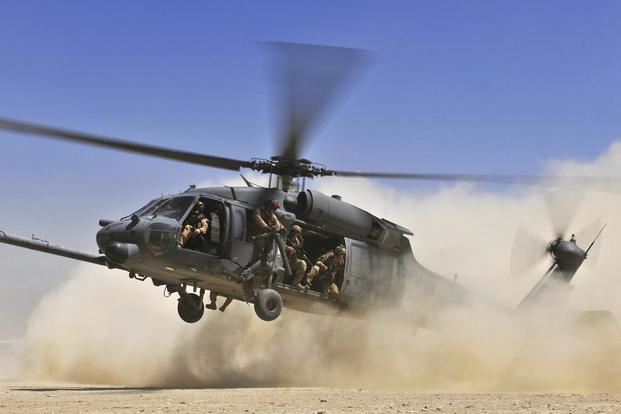The U.S. Air Force's aging combat search-and-rescue helicopter fleet is experiencing a surge in maintenance challenges, leaving fewer available for training and combat environments, according to a new report.
The Government Accountability Office on Thursday said the Sikorsky-made HH-60G Pave Hawk, the service's primary search-and-rescue platform, has seen an increased maintenance rate because the Air Force is flying the helicopter well beyond its intended service life.
"The material condition of the Air Force's HH-60G fleet has declined and maintenance challenges have increased, in part due to extensions beyond the initially designed service life of the helicopters," the report said. As a result, about "68 percent of the 96-helicopter fleet were mission-capable as of fiscal year 2017, below the Air Force desired mission-capable rate of 75 percent."
The 1980s-era HH-60G was intended to fly roughly 6,000 hours over its lifetime. The available helicopters across the fleet currently "average about 7,100 flight hours," according to the report.
Airframes -- the main structure of the aircraft; turboshaft engines; and flight controls are elements that fail most often, the GAO said.
Related content:
- As Tempo Rises, Most Active Reserve Rescue Unit Wants New Aircraft
- For Combat Rescue Units, Space Launch Once Again a Priority
- Air Force Missing Out on Opportunities to Employ F-22, Report Finds
Maintenance time has increased to an average "of more than 25 maintenance man-hours for every flight hour" in fiscal 2017 compared to 21 hours in fiscal 2013. The service also has seen a 40 percent increase in the average time required to conduct more extensive depot-level maintenance, from 233 days in 2007 to 332 days in 2017, the report said.
The helos have been invaluable in operations in Afghanistan, Iraq and even the U.S. for relief efforts such as Hurricane Katrina. The Pave Hawk has a retractable in-flight refueling probe and internal auxiliary fuel tanks that allow for better range and loiter time during rescue missions.
Flight hours have increased over the years due to a higher operations tempo. For example, the Pave Hawk is frequently used in combat ops in the Middle East, where it is often battered by dust storms.
"My concern is, we're already flying an aircraft that's beyond its normal lifespan, and for helicopters it's a lot different than fixed-wing," Col. Kurt Matthews, commander of the 920th Rescue Wing, told Military.com in February.
Military.com toured hangars and facilities on Feb. 20 at Patrick Air Force Base, Florida, used for the combat search-and-rescue mission and spoke with officials about the 920th's evolving operations. The 920th is the only Air Force Reserve rescue wing and is responsible for 18 percent of all the service's rescue missions.
At that time, one of the unit's Pave Hawks had been down for maintenance for eight days because of a corroded wire inside of a cannon plug "somewhere in the aircraft, causing an anomaly in the airplane," said Senior Master Sgt. Dean Peterson, the 920th Aircraft Maintenance Squadron superintendent.
The Air Force plans to replace its aging HH-60Gs in two ways: First, by buying 21 Army UH-60Ls and converting them into the HH-60G Pave Hawk configuration under its Operational Loss Replacement program; and second, by purchasing 112 new Combat Recovery Helicopters, known as the HH-60W, to replace the current Pave Hawk fleet, the report said.
The reconfigured UH-60Ls will be fielded first to active-duty units, six years before they're anticipated to be delivered to the Reserve component. The last of the Sikorsky HH-60Ws -- based on the UH-60M Black Hawk -- are scheduled to be fielded to the active, Guard and Reserve components by fiscal 2029.
Officials from the 920th said they anticipate receiving their first "Whiskey" model in eight to 10 years.
The Air Force until then will continue performing maintenance as necessary, the report said. The GAO had no recommendations, adding that it had requested input from the Defense Department, but none was provided.
The service currently has 82 HH-60G helicopters "designated to meet its personnel recovery mission requirements," the GAO said. The remaining 14 Pave Hawks are designated "for training and, development and testing."
-- Oriana Pawlyk can be reached at oriana.pawlyk@military.com. Follow her on Twitter at @Oriana0214.










